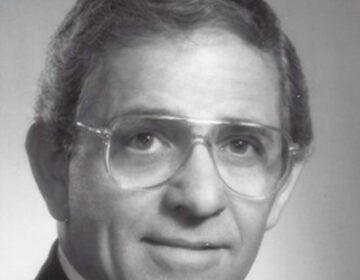Navy Yard: Fields, fields, fields of dreams

March 26, 2009
By Thomas J. Walsh
For PlanPhilly
(Editor’s note: This is the first in an occasional series on planning and development at the Navy Yard.)
While spending the last days of a five-year stint in the U.S. Navy at the Philadelphia Naval Shipyard in late 1991, it was a thrill to explore a base that most fellow Quaker City natives had neither set foot in, nor laid eyes on. There was all that riverfront, some of it with large, pretty white houses that were officers’ quarters – perhaps the city’s best situated riverfront homes.
Huge, wide-open spaces, with weed-choked roads ending in chain-link fences, beyond which stood crumbling housing for long-gone military families. The yawning chasm of dry docks that could berth aircraft carriers. Enormous, ornamental red-brick factories and barracks, beautiful yet forlorn in the absence of the tens of thousands of Philadelphians who used to drive or ferry in each day for good paying jobs.
The Yard officially closed as a military base in 1996. Several years after that, while covering its politically rocky conversion to city-owned property in the late 1990s, it was always a chore to get across to people – residents and non-residents alike – the sheer size of what is still referred to simply as the Navy Yard.
It’s about 1,200 acres, you tell friends and colleagues – the size of Center City. The fact yields blank stares. A decade later, with some significant public and private investment in new office buildings; with several historic conversions of handsome old shops, foundries and airplane hangars; with the Aker company building ships again; and with the Navy itself still a significant presence; it’s just as wide-open and just as fascinating. And nowadays, one can drive right through the front gates without stopping, at the foot of Broad Street, to its terminus at the Delaware River’s edge.
“What we’re focusing on is the idea that the Navy Yard is a real place,” said Mark Seltzer, director of leasing and business development for the Philadelphia Industrial Development Corp. (PIDC), which owns most of the enormous parcels of land at the former base through its public finance entity, the Philadelphia Authority for Industrial Development (PAID). Seltzer gave an update on the Yard recently at the American Institute of Architects offices on Arch Street.
At the Navy Yard, with all that space and all that potential, even just 60 new employees is a cause for celebration. And that’s just what the Nutter administration plans for Friday (March 27), when it is expected to be announced that PENN Capital Management, a financial services firm now headquartered in Cherry Hill, would be re-locating to the Yard later in 2009. PENN Capital bills itself as “an independent, 100 percent employee-owned investment management firm.”
Seltzer said a master plan done by Robert A.M. Stern Architects earlier in this decade was ongoing, including strides made with sustainable infrastructure, the rehabilitation and leasing of historic buildings, new public open spaces and the development of seven miles of waterfront.
Seltzer offered up that acreage comparison with Center City again, and again it stunned people – even industry veterans and longtime Philadelphians.
“It is one of those things that we all think we know about, but we don’t,” said Kiki Bolender, a partner with Schade and Bolender Architects LLP of Center City. What most struck Bolender, though, was the impressive ratio of public financing ($150 million to $400 million) leveraging between $2 billion to $3 billion of private investment, outlined by Seltzer.
That’s going back to one of the first large tenants, in 1999, the Vitetta architectural firm (which took over the large former Marine Corps barracks), and spanning through the recent arrival of Urban Outfitters and other companies, and soon the new headquarters of Tastykake. In 2008 alone, 10 new companies relocated to the Navy Yard.
There was another piece of news that got Bolender’s attention. “Extending the subway down there – boy, talk about a great infrastructure project,” she said. “It’s such a resource down there, even more than any of us could imagine.”
The Broad Street subway extension is “a very real project,” Seltzer said, with “very realistic numbers.” Two new subway stops within the Yard would cost in the neighborhood of $370 million, according to a recently completed feasibility study.
9,000 acres, 50 years
The Stern plan, while it addresses a contained, albeit very large, piece of land, might be a model for other big tracts of empty city property and brownfields.
Planning Commission Executive Director Alan Greenberger, at a recent meeting of the Zoning Code Commission, acknowledged an outside consultant who said that even for a Northeastern city with a history of heavy industry, Philadelphia has “too much” fallow industrial land – about 20 percent of the city’s total area.
“PIDC is in the middle of doing an industrial inventory and map,” he said. “What’s there, what the future of industrial is looking like, which of the lands is appropriate [for any given use], etc.
“PIDC would tell you getting good, accessible land is tough to find – despite the mass – due to pollution, access, residential proximity, etc.,” he continued. “This is a conundrum that any major industrial city faces, but we’re probably near the top of the list. I mean, Philadelphia was known as the ‘Workshop of the World,’ so this should not come as a surprise to anyone.”
In February, Greenberger addressed the issue during a panel discussion at the Mayors’ Institute on City Design conference, held in Philadelphia. A new zoning code is not enough, he said, and a comprehensive citywide plan is needed to deal with the city’s 9,000 acres of industrial land.
That’s about the size of the entire Fairmount Park system, so the city needs all the private partnerships it can get, with the kind of leverage ratios that are the ambition at the Navy Yard. “There’s 50 years of work here,” Greenberger said at the conference. “It’s much more than we can provide as a city.”
Rare sights, hard sells
As for that subway extension, “The question is, is it a right-now project or a six- to 10-year project?” Seltzer said.
Much will depend on continued interest from private companies, attracted by a host of city, state and federal financial incentives that are part of a Navy Yard deal. They include the KOIZ (Keystone Opportunity Improvement Zone), the KIZ (Keystone Innovation Zone), the city’s real estate tax abatement program, and historic preservation tax credits. Organizations like Ben Franklin Technology Partners, now in residence at the Yard, can take advantage of research and development tax credits.
In the here-and-now, though, are major projects that feature rare sights so far in 2009: buildings under construction, with workers hard at it. Liberty Property Trust is the main player at the Yard for office space. Just inside the main gates, to the east, are two new buildings with curving glass facades on the new Crescent Drive. A putting green sits amid a new outdoor park for office workers. The second building (Three Crescent Drive, with 90,000 square feet of space) will be complete this year and is 70 percent preleased. In all, Liberty has $85 million in new projects underway.
Tasty Baking Company’s corporate headquarters will be moving to the Yard this year, with a new state-of-the-art baking facility set to open in 2010.
PIDC has some $65 million in infrastructure improvements underway, including a new 26th Street entrance. What the organization calls its “Town Center” project is in the historic area, much of it just east of Broad Street and closer the river, where spacious empty barracks, office buildings, shops and even a chapel await redevelopment.
And last summer, Mayor Nutter announced a large-scale solar facility to be developed in partnership with Exelon on one of the Yard’s brownfield sites, a seven-acre piece of land on the Girard Point industrial area of the Yard’s southwest end.
The surreal nature of it all
Driving around the Navy Yard, it is striking – but common – to see soaring, architecturally interesting buildings alongside ramshackle, rusted-out warehouses and factories. Yet, parts of the Yard’s eastern side, with the beginnings of a research park, a hoped-for marina district and the barren Mustin air field (part of which could become part of a new shipping terminal being planned by the Commonwealth: http://www.planphilly.com/node/8486), consist of some of the largest open spaces you are ever likely to see in an urban setting. Several streets full of dilapidated family housing still stand, hemmed in by high fences and surrounded by wide, desolate roads.
Each area – industrial, office, historic center, what-have-you – is hundreds of acres in size.
On the west side, the very large Aker shipyard is humming, producing 2.5 ships a year. Seltzer says it is the most productive shipbuilding facility in the United States. That might surprise historians, who consider the Delaware River of the 19th and 20th centuries the most concentrated area of shipbuilding in the world, with dozens of long-shuttered shipyards on both sides of the river building everything from wooden clipper ships to battleships and aircraft carriers.
Meanwhile, the Navy not only remains a big partner in the redevelopment efforts, but it is in fact expanding again, Seltzer said. Even after the base closure, the Naval Surface Warfare Center’s Ship Systems Engineering Station (NAVSSES) stayed on, along with the mothballed fleet of haze gray ships in the tidal basin that is plainly visible to motorists above the facility, on Interstate 95.
Part of the reason the Navy Yard is still such an enigma to many Philadelphians is that traditionally it had been gated, with passes needed for vehicular or pedestrian access. These days, Seltzer said, the gate remains, but the base is open to the public from 8 a.m. to 5 p.m., Monday through Friday.
You’ll be welcomed, and asked to pardon their appearance. Take a good look around, but take it from PlanPhilly: Don’t take any pictures over by the Aker property.
Next in the series: A dream sector for the Navy Yard, featuring a high-profile, worldwide American export.
ON THE WEB: www.NavyYard.org

Thomas J. Walsh, who has been writing extensively for PlanPhilly since January 2008, was a Navy broadcast journalist from 1986 through 1991. He was stationed with the Naval Broadcasting Service in Diego Garcia, a British Indian Ocean base, and aboard the USS Forrestal, an aircraft carrier based in Jacksonville, Fla. (decommissioned). A Temple University grad, he has since then been a business and features writer at daily and weekly newspapers (including the Philadelphia Business Journal and Philadelphia Inquirer), and was an original member of one of the first profitable Web-based news services, Commercial Real Estate Direct, with national coverage beginning in 1999. Tom covered the gaming and tourism business in the Reno-Lake Tahoe area of Northern Nevada for two years. He is now a fulltime freelance journalist and a consultant to several large Philadelphia area economic development organizations and nonprofits.
Contact the reporter at thomaswalsh1@gmail.com.
WHYY is your source for fact-based, in-depth journalism and information. As a nonprofit organization, we rely on financial support from readers like you. Please give today.





